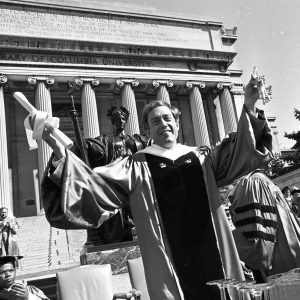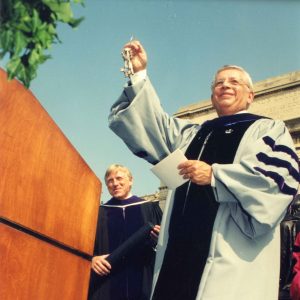At each presidential inauguration ceremony at Columbia, the Chair of the Board of Trustees presents the new President with the charter and keys to the University. In 1993, President George Rupp was notably struck by the very large crown-topped keys. Today we reveal the origins of the presidential keys to the University.

On October 4, 1993, the Chair of the University Trustees Henry King presented George Rupp with a copy of the 1754 King’s College Charter and the seven crown-topped keys to the University in a symbolic transfer of power. As King said in 1993: “If keys imply gates, then we like to think that Columbia’s gates of learning always stand open.” But the large and heavy keys struck Rupp (and many others present) who wondered about what exactly the keys were for. Rupp joked: “They have enormous authority. They open every door of every treasure chest we have at Columbia.” On hand for the festivities was Rupp’s predecessor, President Michael I. Sovern. After 13 years as the keeper of the keys, Sovern admitted that he did not know what the keys opened: “Maybe they once did open something, but those doors are long gone.”
We can now reveal that the keys are purely symbolic and that they never opened any gates, doors or treasure chests. For an institution dating back to 1754, the ornate keys are actually a fairly recent addition to the old investiture tradition. This set of ceremonial keys only dates back to 1902 and the installation of Nicholas Murray Butler as President of Columbia University. The University had just moved to Morningside Heights in 1897 and this was the very first presidential inauguration on the new campus. While the University was still growing (and still using some of the old Bloomingdale Asylum buildings on the grounds), there were at the time seven new Columbia buildings on the site: the Library (now Low), Physics (now Fayerweather), Schermerhorn, Engineering (now Mathematics), Havemeyer, University (where Uris stands), and Earl Hall. The seven keys symbolize each of the new buildings on the new campus.
The ceremonial keys made their second appearance in 1948 when General Dwight David Eisenhower became President of Columbia. There was local and nationwide press coverage of the event but permission to take photographs was restricted to the culminating point of the ceremony — yes, the presentation of the keys and charter.

The keys would have to wait a while for their next public appearance. In 1953 Eisenhower resigned to become President of the United States. As the University was about to hold a year-long celebration for Columbia’s Bicentennial, there was no public inaugural ceremony for his successor, President Grayson Kirk. And again, in a politically charged and financially challenged 1970, President William McGill canceled his own formal inauguration and moved the ceremony’s budgeted allocation towards financial aid.
Sovern (1980), Rupp (1993) and Bollinger (2002) all received the keys and charter in succession. And the seven crown-topped ceremonial keys will surely be on hand for Columbia’s next President.